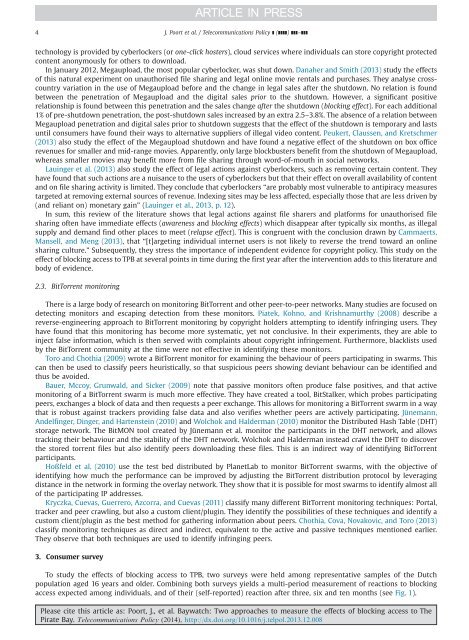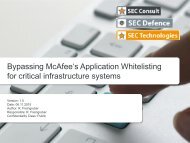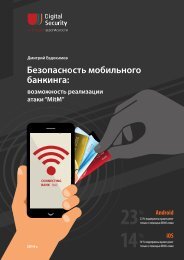1401-Baywatch
1401-Baywatch
1401-Baywatch
Create successful ePaper yourself
Turn your PDF publications into a flip-book with our unique Google optimized e-Paper software.
4<br />
J. Poort et al. / Telecommunications Policy ] (]]]]) ]]]–]]]<br />
technology is provided by cyberlockers (or one-click hosters), cloud services where individuals can store copyright protected<br />
content anonymously for others to download.<br />
In January 2012, Megaupload, the most popular cyberlocker, was shut down. Danaher and Smith (2013) study the effects<br />
of this natural experiment on unauthorised file sharing and legal online movie rentals and purchases. They analyse crosscountry<br />
variation in the use of Megaupload before and the change in legal sales after the shutdown. No relation is found<br />
between the penetration of Megaupload and the digital sales prior to the shutdown. However, a significant positive<br />
relationship is found between this penetration and the sales change after the shutdown (blocking effect). For each additional<br />
1% of pre-shutdown penetration, the post-shutdown sales increased by an extra 2.5–3.8%. The absence of a relation between<br />
Megaupload penetration and digital sales prior to shutdown suggests that the effect of the shutdown is temporary and lasts<br />
until consumers have found their ways to alternative suppliers of illegal video content. Peukert, Claussen, and Kretschmer<br />
(2013) also study the effect of the Megaupload shutdown and have found a negative effect of the shutdown on box office<br />
revenues for smaller and mid-range movies. Apparently, only large blockbusters benefit from the shutdown of Megaupload,<br />
whereas smaller movies may benefit more from file sharing through word-of-mouth in social networks.<br />
Lauinger et al. (2013) also study the effect of legal actions against cyberlockers, such as removing certain content. They<br />
have found that such actions are a nuisance to the users of cyberlockers but that their effect on overall availability of content<br />
and on file sharing activity is limited. They conclude that cyberlockers “are probably most vulnerable to antipiracy measures<br />
targeted at removing external sources of revenue. Indexing sites may be less affected, especially those that are less driven by<br />
(and reliant on) monetary gain” (Lauinger et al., 2013, p. 12).<br />
In sum, this review of the literature shows that legal actions against file sharers and platforms for unauthorised file<br />
sharing often have immediate effects (awareness and blocking effects) which disappear after typically six months, as illegal<br />
supply and demand find other places to meet (relapse effect). This is congruent with the conclusion drawn by Cammaerts,<br />
Mansell, and Meng (2013), that “[t]argeting individual internet users is not likely to reverse the trend toward an online<br />
sharing culture.” Subsequently, they stress the importance of independent evidence for copyright policy. This study on the<br />
effect of blocking access to TPB at several points in time during the first year after the intervention adds to this literature and<br />
body of evidence.<br />
2.3. BitTorrent monitoring<br />
There is a large body of research on monitoring BitTorrent and other peer-to-peer networks. Many studies are focused on<br />
detecting monitors and escaping detection from these monitors. Piatek, Kohno, and Krishnamurthy (2008) describe a<br />
reverse-engineering approach to BitTorrent monitoring by copyright holders attempting to identify infringing users. They<br />
have found that this monitoring has become more systematic, yet not conclusive. In their experiments, they are able to<br />
inject false information, which is then served with complaints about copyright infringement. Furthermore, blacklists used<br />
by the BitTorrent community at the time were not effective in identifying these monitors.<br />
Toro and Chothia (2009) wrote a BitTorrent monitor for examining the behaviour of peers participating in swarms. This<br />
can then be used to classify peers heuristically, so that suspicious peers showing deviant behaviour can be identified and<br />
thus be avoided.<br />
Bauer, Mccoy, Grunwald, and Sicker (2009) note that passive monitors often produce false positives, and that active<br />
monitoring of a BitTorrent swarm is much more effective. They have created a tool, BitStalker, which probes participating<br />
peers, exchanges a block of data and then requests a peer exchange. This allows for monitoring a BitTorrent swarm in a way<br />
that is robust against trackers providing false data and also verifies whether peers are actively participating. Jünemann,<br />
Andelfinger, Dinger, and Hartenstein (2010) and Wolchok and Halderman (2010) monitor the Distributed Hash Table (DHT)<br />
storage network. The BitMON tool created by Jünemann et al. monitor the participants in the DHT network, and allows<br />
tracking their behaviour and the stability of the DHT network. Wolchok and Halderman instead crawl the DHT to discover<br />
the stored torrent files but also identify peers downloading these files. This is an indirect way of identifying BitTorrent<br />
participants.<br />
Hoßfeld et al. (2010) use the test bed distributed by PlanetLab to monitor BitTorrent swarms, with the objective of<br />
identifying how much the performance can be improved by adjusting the BitTorrent distribution protocol by leveraging<br />
distance in the network in forming the overlay network. They show that it is possible for most swarms to identify almost all<br />
of the participating IP addresses.<br />
Kryczka, Cuevas, Guerrero, Azcorra, and Cuevas (2011) classify many different BitTorrent monitoring techniques: Portal,<br />
tracker and peer crawling, but also a custom client/plugin. They identify the possibilities of these techniques and identify a<br />
custom client/plugin as the best method for gathering information about peers. Chothia, Cova, Novakovic, and Toro (2013)<br />
classify monitoring techniques as direct and indirect, equivalent to the active and passive techniques mentioned earlier.<br />
They observe that both techniques are used to identify infringing peers.<br />
3. Consumer survey<br />
To study the effects of blocking access to TPB, two surveys were held among representative samples of the Dutch<br />
population aged 16 years and older. Combining both surveys yields a multi-period measurement of reactions to blocking<br />
access expected among individuals, and of their (self-reported) reaction after three, six and ten months (see Fig. 1).<br />
Please cite this article as: Poort, J., et al. <strong>Baywatch</strong>: Two approaches to measure the effects of blocking access to The<br />
Pirate Bay. Telecommunications Policy (2014), http://dx.doi.org/10.1016/j.telpol.2013.12.008i






